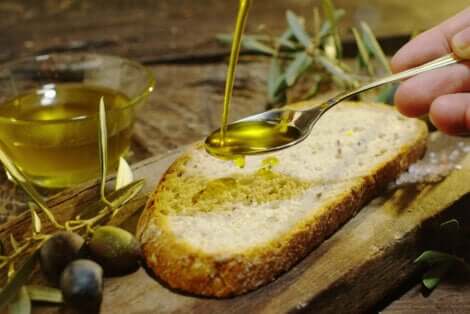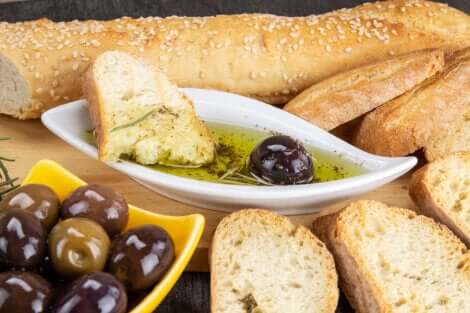Bread and Olive Oil: The Perfect Combination


Written and verified by psychologist Valeria Sabater
Bread and olive oil is a common breakfast choice for many people. It’s a staple of the Mediterranean diet that has spread all over the world, and, of course, we love it!
Okay, but is it really that healthy? Won’t it make you gain weight? Isn’t it a bad idea to eat it every single day? The answer to these questions is very simple. You can eat your bread and olive oil with total peace of mind, as it’s a healthy combination. However, not all the time.
Here are five reasons why you should add a slice of whole grain bread with a tablespoon of extra virgin olive oil to your breakfasts.
Bread and olive oil: five reasons to have it every day

If you don’t have a lot of time in the morning, don’t worry: a slice of bread with some olive oil, a piece of fruit, and a coffee can be a lifesaver.
Likewise, if you find yourself hungry again at noon or want to have something healthy when you get home from work, this is still a great option. However, it’s still important to remember a few simple rules:
- Always choose extra virgin olive oil. It contains omega-3 fatty acids, which have been shown to be beneficial for cardiovascular health.
- Avoid white bread or bread made with refined white flour.
- Always look for more natural options, such as rye, oatmeal, and whole grain bread. Thanks to their fiber contribution, they’re able to stimulate the feeling of satiety, according to a study published in the European Journal of Clinical Nutrition.
- It isn’t about consuming bread with oil at every meal. A slice once a day is the best bet.
Below, we’ll explain why this dietary option is so good for you.
Discover: How to Make Delicious Coconut and Almond Bread

1. It’s complete nutrition that won’t make you gain weight
Aside from being delicious, bread and olive oil can provide you with some essential nutrients. With a single slice, you’ll get carbohydrates and vitamins B1, B2, B6, and B9, along with iron, magnesium, zinc, and potassium. All of that, and no saturated fat!
2. It’s good for your heart health
Olive oil is a natural health treasure, especially for the heart and arteries. There’s evidence that it helps to modulate the lipid profile. Its monounsaturated and polyunsaturated fatty acids are healthy fats that allow you to keep the so-called bad cholesterol or LDL at bay.
One of the biggest benefits of combining bread and olive oil is vitamin E. It helps you fight atherosclerosis and regulate your blood pressure.
Read: Omega-3-Rich Fish That You Should Start Eating
3. It aids digestion and helps avoid constipation
Poor digestion, gas, acid reflux, and even constipation can be alleviated if you eat a little bread and olive oil every day.
It lowers your body’s acid production and optimizes intestinal function. This tasty combination is even a mild laxative, which is part of why it’s so good to include it in your first meal of the day.
4. It fights depression
Olive oil contains polyphenols. This particular type of monounsaturated fat is anti-inflammatory, improves your sense of well-being, and increases your endorphin levels. It’ll make you feel good because your body feels good when your heart is functioning optimally and you have less cellular oxidation.
5. Bread and olive oil detoxes your liver
- If you’re the kind of person who doesn’t like to start the day off with a glass of water and lemon juice, replace it with bread and olive oil.
- This will help you detox your liver and gallbladder. It packs an excellent combination of antioxidants and vitamin E that optimize liver function and improve the liver’s ability to cleanse itself.
- If you have fatty liver disease, eating a slice of bread with olive oil on a daily basis is also a very healthy natural remedy.
Healthy ways to have bread with olive oil

There are several different ways to enjoy this healthy, delicious combination by adding other ingredients that will enhance its already amazing properties. Here are a few simple options.
Option 1
- Toast a slice of rye or oat bread.
- Crush a clove of garlic and spread it onto the toast. Then add a splash of olive oil.
Option 2
- Take an entire loaf of bread.
- Make several slices along the top but don’t cut it.
- Add some olive oil, garlic, and parsley.
- Bake for a few minutes.
We recommend you read: The Influence of the Mediterranean Diet on Intestinal Health
Option 3
- Toast a slice of bread.
- Add half a tomato.
- Add a dash of olive oil.
Option 4
- Take a slice of bread.
- Add a bit of olive oil.
- Chop some nuts and sprinkle them over the toast.
- Add a little white pepper.
- Toast it briefly.
Option 5
- Toast a slice of bread.
- Add a little oregano, some crushed tomato, and a little olive oil.
A slice of bread with olive oil can be a good option
Finally, remember that it’s never a good idea to add lots of salt to any of these options. You also shouldn’t overdo it. Seek moderation instead.
All cited sources were thoroughly reviewed by our team to ensure their quality, reliability, currency, and validity. The bibliography of this article was considered reliable and of academic or scientific accuracy.
- Mori TA. Marine OMEGA-3 fatty acids in the prevention of cardiovascular disease. Fitoterapia. 2017 Nov;123:51-58.
- Warrilow A, Mellor D, McKune A, Pumpa K. Dietary fat, fibre, satiation, and satiety-a systematic review of acute studies. Eur J Clin Nutr. 2019 Mar;73(3):333-344
- Omar ZA, Montser BA, Farahat MAR. Effect of high-dose Omega 3 on lipid profile and inflammatory markers in chronic hemodialysis children. Saudi J Kidney Dis Transpl. 2019 May-Jun;30(3):634-639.
This text is provided for informational purposes only and does not replace consultation with a professional. If in doubt, consult your specialist.








